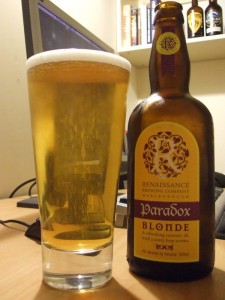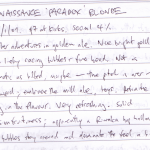
By “blonde”, here, they mean “golden ale”. You can see I’ve developed an obsession. It’s a great bright gold with lively racing bubbles that make a fine head which lasts all the way down the glass and make for an notably (but enjoyably) fizzy feel. It’s perhaps not as aromatic as billed — the text on the bottle is full of zesty and bursty and exclamatory tone that makes me want to counsel them to just calm down and embrace the nature of the lovely mild ale instead. (As I mentioned with the previous beer, some people expect too much of golden ales — it’s just odd that, here, it seems to be the people marketing one that miss the point a touch. But I forgive them.)
It does have a definite zing, and is brilliantly refreshing. There’s a solid passionfruitiness to it, which is apparently a hallmark of the Riwaka hops used — and probably accounts for the label’s colour scheme, too.

Verbatim: Renaissance ‘Paradox’ Blonde. 21/1/09 $7 at Kirks. 500ml 4%. Further adventures in golden ale. Nice bright gold with lively racing bubbles + fine head. Not as aromatic as billed, maybe — the pitch is over-enthused; embrace the mild ale, boys. Definite zing in the flavour. Very refreshing. Solid passionfruitiness; apparently a Riwaka hop hallmark. The bubbles stay around and dominate the feel a bit.
Afterthoughts, November 2010: “Blonde” is one of those abused / overused words in the beer world where you really have to ask someone exactly what they mean by it before you can talk to them if they strike up a conversation / ask a question. If you’re European, it’s Belgian-ish boozy light-ish ale; if you’re American, it’s wheat beer, usually more Belgian-ish than German-ish; if you’re Australian, it’s low-carb lager. It does get confusing.
“Draught” is a similar word, but worse still.
